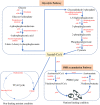A Review on Enhancing Cupriavidus necator Fermentation for Poly(3-hydroxybutyrate) (PHB) Production From Low-Cost Carbon Sources
- PMID: 35928944
- PMCID: PMC9343952
- DOI: 10.3389/fbioe.2022.946085
A Review on Enhancing Cupriavidus necator Fermentation for Poly(3-hydroxybutyrate) (PHB) Production From Low-Cost Carbon Sources
Abstract
In the context of a circular economy, bioplastic production using biodegradable materials such as poly(3-hydroxybutyrate) (PHB) has been proposed as a promising solution to fundamentally solve the disposal issue of plastic waste. PHB production techniques through fermentation of PHB-accumulating microbes such as Cupriavidus necator have been revolutionized over the past several years with the development of new strategies such as metabolic engineering. This review comprehensively summarizes the latest PHB production technologies via Cupriavidus necator fermentation. The mechanism of the biosynthesis pathway for PHB production was first assessed. PHB production efficiencies of common carbon sources, including food waste, lignocellulosic materials, glycerol, and carbon dioxide, were then summarized and critically analyzed. The key findings in enhancing strategies for PHB production in recent years, including pre-treatment methods, nutrient limitations, feeding optimization strategies, and metabolism engineering strategies, were summarized. Furthermore, technical challenges and future prospects of strategies for enhanced production efficiencies of PHB were also highlighted. Based on the overview of the current enhancing technologies, more pilot-scale and larger-scale tests are essential for future implementation of enhancing strategies in full-scale biogas plants. Critical analyses of various enhancing strategies would facilitate the establishment of more sustainable microbial fermentation systems for better waste management and greater efficiency of PHB production.
Keywords: biodegradable plastic; metabolic engineering; microbial fermentation; polyhydroxyalkanoates; process engineering; resource recovery; waste management.
Copyright © 2022 Zhang, Jiang, Tsui, Loh, Dai and Tong.
Conflict of interest statement
The authors declare that the research was conducted in the absence of any commercial or financial relationships that could be construed as a potential conflict of interest.
Figures
Similar articles
-
Improved fermentation strategies in a bioreactor for enhancing poly(3-hydroxybutyrate) (PHB) production by wild type Cupriavidus necator from fructose.Heliyon. 2021 Jan 23;7(1):e05979. doi: 10.1016/j.heliyon.2021.e05979. eCollection 2021 Jan. Heliyon. 2021. PMID: 33537471 Free PMC article.
-
Harnessing the potential of Cupriavidus necator for CO2 capture from alcoholic fermentation and its bioconversion into poly(3-hydroxybutyrate).Bioresour Technol. 2025 Mar;419:132060. doi: 10.1016/j.biortech.2025.132060. Epub 2025 Jan 11. Bioresour Technol. 2025. PMID: 39805476
-
Poly(3-hydroxybutyrate) production for food packaging from biomass derived carbohydrates by cupriavidus necator DSM 545.Enzyme Microb Technol. 2024 Dec;181:110516. doi: 10.1016/j.enzmictec.2024.110516. Epub 2024 Sep 17. Enzyme Microb Technol. 2024. PMID: 39303458
-
Industrial side streams as sustainable substrates for microbial production of poly(3-hydroxybutyrate) (PHB).World J Microbiol Biotechnol. 2022 Oct 19;38(12):238. doi: 10.1007/s11274-022-03416-z. World J Microbiol Biotechnol. 2022. PMID: 36260135 Free PMC article. Review.
-
Cupriavidus necator as a platform for polyhydroxyalkanoate production: An overview of strains, metabolism, and modeling approaches.Biotechnol Adv. 2023 Dec;69:108264. doi: 10.1016/j.biotechadv.2023.108264. Epub 2023 Sep 27. Biotechnol Adv. 2023. PMID: 37775073 Review.
Cited by
-
Toward the production of block copolymers in microbial cells: achievements and perspectives.Appl Microbiol Biotechnol. 2024 Jan 22;108(1):164. doi: 10.1007/s00253-023-12973-8. Appl Microbiol Biotechnol. 2024. PMID: 38252290 Free PMC article. Review.
-
Genetic engineering of low-temperature polyhydroxyalkanoate production by Acidovorax sp. A1169, a psychrophile isolated from a subglacial outflow.Extremophiles. 2023 Sep 14;27(3):25. doi: 10.1007/s00792-023-01311-5. Extremophiles. 2023. PMID: 37709928 Free PMC article.
-
Sucrose-Based Screening of a Novel Strain, Limimaricola sp. YI8, and Its Application to Polyhydroxybutyrate Production from Molasses.Polymers (Basel). 2025 May 26;17(11):1471. doi: 10.3390/polym17111471. Polymers (Basel). 2025. PMID: 40508716 Free PMC article.
-
Isolation and characterization of a bacteria of Cupriavidus genus from Indian Himalayan region and its evaluation for production of Poly-3-hydroxybutyrate.Arch Microbiol. 2025 Aug 20;207(9):231. doi: 10.1007/s00203-025-04425-w. Arch Microbiol. 2025. PMID: 40833483
-
Rhamnolipid-Modified PHB-Ectoine Nanoparticles for Multifunctional Skin Protection Against UVB, Irritation, and Bacteria.ACS Omega. 2025 Mar 17;10(12):12200-12213. doi: 10.1021/acsomega.4c10583. eCollection 2025 Apr 1. ACS Omega. 2025. PMID: 40191376 Free PMC article.
References
-
- Aeschelmann F., Carus M. (2015). Biobased Building Blocks and Polymers in the World: Capacities, Production, and Applications–Status Quo and Trends towards 2020. Ind. Biotechnol. 11 (3), 154–159. 10.1089/ind.2015.28999.fae - DOI
-
- Alves A. A., Siqueira E. C., Barros M. P. S., Silva P. E. C., Houllou L. M. (2022). Polyhydroxyalkanoates: a Review of Microbial Production and Technology Application. Int. J. Environ. Sci. Technol., 1–12. 10.1007/s13762-022-04213-9 - DOI
Publication types
LinkOut - more resources
Full Text Sources
Molecular Biology Databases
Miscellaneous



